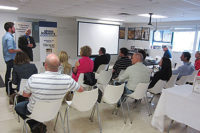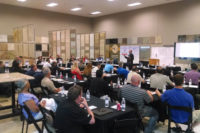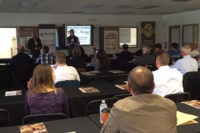Fabricators and other members of the stone industry living in the Seattle, WA, area, came together on Thursday, May 19, 2016 for the Washington Stone Summit, which was part of the Stone Industry Education Seminar program run by MIA+BSI and Stone World. The all-day event, which was hosted by MS International, Inc. (MSI) at its showroom and warehouse facility, included a continental breakfast during the morning registration and networking period followed by a morning discussion on stone shop management, which was led by Tony Malisani of Malisani Inc. in Great Falls, MT. Additionally, the workshop included time for lunch and networking, as well as a tour of MSI’s facility and afternoon breakout discussions. The day ended with a reception that allowed participants to talk with each other as well as the sponsors of the event, which included Baca Systems, Blanco, Bonstone, Braxton-Bragg, Integra Adhesives, Laser Products, Moraware, Park Industries, Prussiani and Water Treatment Solutions.
Malisani is owner of a third-generation stone shop, and has been working in the stone industry for 20 years. His business specializes in high-end custom work from fountains, monuments and custom furniture to countertops. Malisani has extensive knowledge about business management in the stone industry with the understanding of the growing-opportunities for a small business, and Malisani Inc. was one of the first companies in the nation to receive the “Natural Stone Accredited Fabricator” credential. In 2010, Malisani was also elected to serve a five-year term on the MIA Board of Directors.
To kick off the Washington Stone Summit, Malisani asked participants what topics they would like to see covered during the morning talk. Among those that came up were:
• Quality and standards
• Adhesives applications
• Shop drawings
• New material
• New technology
• How OSHA affects business
When discussing quality and standards, Malisani explained that an important part of business practice is not to just set expectations, but let customers know what is realistic. “Try to set yourself up for success,” he said. “Determine their expectations. Talk to them about it. You may have done this a million times, but they are probably doing it for the first time.
“The more professional you are, the more professional your competition has to be to compete with you,” Malisani continued. “Understand that if you are doing a great job and are very professional, you are setting the standards.”
Malisani also instructed the audience that everything needs to be customized to their organization and what they do. It is critical for fabricators to know their market, efficiency, etc. “Planning becomes integral in where you want to be and what you want to do,” he said.
Another topic Malisani spent some time on was metrics. He asked attendees to give him some reasons for using metrics. They included:
• Gives an organization direction — management and administration
• Creates an atmosphere of efficiency
• Helps with planning and equipment purchases
• Gives employees buy-in and a sense of purpose
Additionally, Malisani explained that stone fabrication facility metrics can measure a profit or loss on projects and utility bills. “There is software that is amazing and you can take it to the point you want,” he said, adding that metrics can be captured through equipment reports, employee reports and business systems.
Handling customer complaints was also addressed during the morning session. “Try to collect the payment right away,” said Malisani. “You don’t want to give a homeowner time to look for problems and reasons not to pay. Do not leave the residence until they are happy and give you a check.”
When a customer does have a complaint, the first step is to identify what the complaint is, explained Malisani. “Have someone there to make an all-encompassing list and find out what the problem is,” he said.
One audience member said that he finds timeliness is best when a problem arises. “The longer you wait, the harder it is to diffuse,” said the fabricator. Another participant said he gets everyone on the project involved. “I have a meeting with the builder and the homeowner,” he said. “The builder and I go outside to talk about it and come up with a solution and then go back and talk with the homeowner.”
“Define what the resolution is,” said Malisani. “Understand this could be their ‘House Moment.’ For you, it is the ‘Davis’ or ‘Johnson’ job, but they might have been saving for 10 years.”
Some time was also dedicated to discussing the new Silicosis ruling, which cuts the Personal Exposure Level (PEL) in half. “The important thing to understand with OSHA is that they would prefer that you take care of things on the engineering side rather than PEL,” said Malisani. “Use water for everything — that is the biggest thing. Use a wet process as much as you can.”
One fabricator told participants that he invites OSHA into his shop. “I have had them in three times, and each time, I have learned a lot,” he said. “They aren’t going to fine you. They want to help. We were a dry shop. I fought it for a long time, but I had to change my ways. We went to CNC and became a wet shop.”
“Have a good relationship with OSHA,” said Malisani. “Try to get along with them. If you do a voluntary [visit] in Montana, then they will notify you if they are coming in for an inspection within three years. We have been doing this for years. We have people every year have a spirometry and a fitting test. You cannot sign away your ability to be safe. You have to take test.”
Breakout session
After lunch, the group divided into two break groups. While one talked about business standards, the other focused on technological aspects of stone fabrication. The groups were led by Michael Homchick of Michael Homchick Stoneworks of Kenmore, WA, and Jeremey Jackson, owner of North West Granite & Flooring LLC in Oak Harbor, WA.
Among the topics that surfaced in the business standards group was out-of-town jobs. Homchick explained to the group that his company pays workers who travel out of town a per diem of $45 per day plus their hourly rate. “We have employees going down to Florida so you have to give them something that works,” he said. “A lot of times they get overtime. They like the travel, and they make good money when they work out of town.”
A member of the audience told the group that his company uses the VeriClock application to track their employees’ time. VeriClock allows employees to clock in and out of the system via phone, smart phone or the web, eliminating the need for specialized hardware or software and doing away with manual time sheets. Managers can view, verify and report on employee hours in real-time. The audience member said that the application works very well for them.
Changing the subject, another participant enquired about the benefits of having a CNC machine if you still have to finish the job by hand? “It is a giant investment,” said Homchick. “You have to have a really dedicated sawyer and CNC guy, and there is minimal finishing. We use waterjet and CNC to shape things and always finish by hand. It takes more time and costs more, but it is a much better quality. We do it because we do custom residential projects.”
“You have to get to that business level that it makes sense,” said one fabricator. “It is not only a checkbook investment, but a mental investment. If you are there, and feel you have a market captured, it will increase your efficiency — sometimes by five times.”
According to Homchick, investing in a CNC should be driven by a company’s customers. “It’s a respect thing,” he said. “People take you seriously if they see you made the investment. Whatever machinery I buy, I always have a job in mind that will pay for most of it.
“The people running the CNC machines really need to be treated like gold,” Homchick went on to say. “I see shops where the operator left and the machines just sit. Pay them well and have a second backup guy. CNC is smart and I think it is the wave of the future.”
Estimating was also discussed among the fabricators. “It’s one of the things I have really enjoyed,” said Homchick. “Part of it is I have always been a hands-on person.
I am kind of notorious for having kind of high prices, but I don’t miss things,” he went on to say. “You obviously want to be competitive, but you shouldn’t care what other people charge. Don’t ever use other people’s prices; it is a pitfall. You have to base it on your own needs. What it costs you.”
One participant explained that it is critical to double check what your cost is before you give your final cost to the customer. Homchick told the group it is important to base the price on the type of stone. “Every stone has a personality that you don’t know until you work with it,” he said.
And everyone in the group was in agreement that bargain hunters are not compatible to the stone industry. “The problem with bargain hunters is that they require more time,” said Homchick. One participant shared his secret of combatting them. “If we can tell it is someone that is going to ask for a discount, we automatically mark it up 10%.”
Read more about the Washington Stone Summit, check out the sidebar article:












